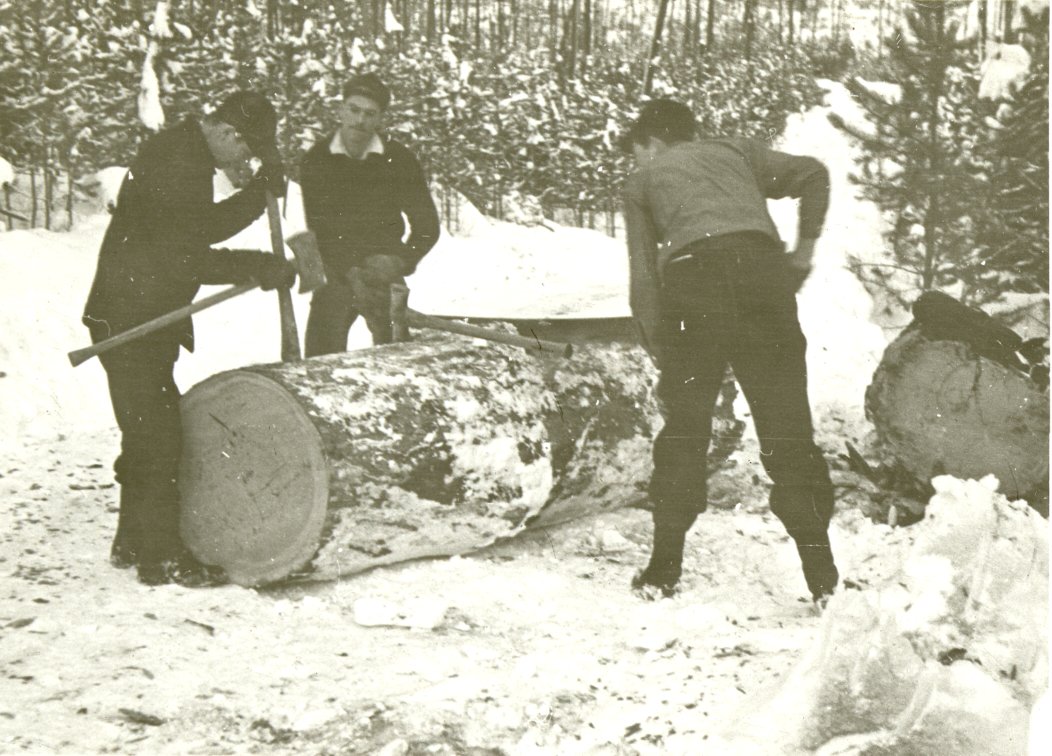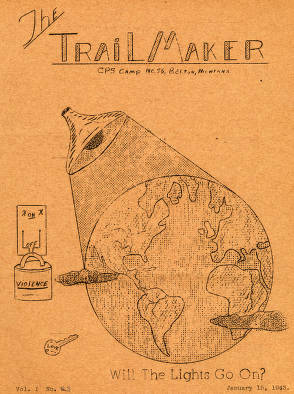CPS Unit Number 055-01
Camp: 55
Unit ID: 1
Operating agency: MCC
Opened: 9 1942
Closed: 10 1946
Workers
Total number of workers who worked in this camp: 560
-
 CPS Camp No. 55, Belton, MontanaCivilian Public Service camp 55, Belton, Montana.Box 1, Folder 28. MCC Photographs, Civilian Public Service, 1941-1947. IX-13-2.2. Mennonite Central Committee Photo Archive
CPS Camp No. 55, Belton, MontanaCivilian Public Service camp 55, Belton, Montana.Box 1, Folder 28. MCC Photographs, Civilian Public Service, 1941-1947. IX-13-2.2. Mennonite Central Committee Photo Archive -
 CPS Camp No. 55The Trailmaker was a newsletter published by the men at Camp 55 from November 1942 to December 1944.Digital Image from American Friends Service Committee: Civilian Public Service Records (DG002), Swarthmore College Peace Collection, Swarthmore, Pennsylvania
CPS Camp No. 55The Trailmaker was a newsletter published by the men at Camp 55 from November 1942 to December 1944.Digital Image from American Friends Service Committee: Civilian Public Service Records (DG002), Swarthmore College Peace Collection, Swarthmore, Pennsylvania
CPS Camp No. 55, a National Park Service base camp located in a former Civilian Conservation Corps camp near Belton, Montana operated by Mennonite Central Committee, opened in September 1942 and closed in October 1946. The men worked to suppress and prevent forest fires, control tree disease, and maintain the park.
CPS Camp No. 55, housed in a former CCC camp just inside Glacier National Park, was a half mile from Belton, Montana, a flag stop on the Great Northern Railroad. The Middle Fork of the Flathead River flowed nearby. The town name changed from Belton to West Glacier in 1949.
Directors: Wilbert Nafziger, Jesse Harder, Al Zook, Dan Neufeld, Richard Weaver, Sturges Miller
Dieticians: Marie Groening, Mrs. Melvin H. Lauver, Gladys Neufeld, Katie Yoder, Ellen Zimmerman
Matrons: Virginia Weaver
Nurse: Dorothy Klassen, Mrs. W. F. Unruh, Thelma Unruh
Nurse-Matron: Marie Ediger, Catherine Harder, Mary E. Hostetler, Mrs. Wilbert A. Nafziger
Thirty-one assignees transferred from Colorado Springs CPS Camp No. 5 and Fort Collins CPS Camp No. 33 when Belton opened. Two months later one hundred and fifty men from nineteen states, eleven CPS camps and ten denominations made up the camp community. Spouses of some married men followed them to the camp. Due to an anticipated heavy fire season in 1945, Selective Service transferred additional men so that the camp number grew to two hundred and seven.
The majority of the assignees reported religious affiliation as Mennonite when entering CPS.
During the war emergency, CPS men provided man power for forest fire pre-suppression and suppression, fire hazard reduction, tree disease control, as well as limited maintenance of camp grounds, trails, roads, buildings and related work.
The men worked to control tree disease in both Glacier National Park and Yellowstone National Park.
During the winter, the men cut down snags in burned out areas. In the winter of 1943-45, they cut one hundred thousand board feet of timber used to repair and build trails and wagon bridges. In spring they repaired and maintained one thousand miles of trails in the park.
During summer, many of the men worked from side camps to perform fire watch, pre-suppression and fight fires. “From July 1, 1945, to June 1, 1946, a total of 1,934 person-days were spent . . .fighting forest fires. In the two previous years the figures were 310 and 68 respectively.” (Gingerich p. 158)
N. Paul Stucky was in charge of the infirmary for several weeks. “When the radio system of Glacier National Park became inoperative, I was asked to ‘come and look’. That worked out well, and I worked with the radio and telephone systems until the opening of Relief Training School.” (The Eden Peace Witness: A Collection of Personal Accounts pp. 151-153)
A government report sent regarding Camp No. 55 to Colonel Kosch, Director of Camp Operations for the Selective Service, viewed the work of individuals favorably, while also acknowledging some difference of opinion on “what constituted work of national importance”. Yet the Forest Service added that it was able to accomplish approved jobs regardless of CO opinion. “Work output of CPS Camp 55 was far greater than that of any CCC Camp which has been assigned to Glacier”. (Gingerich p. 159)
Wives often followed their CO husbands and found housing in towns not far from the camps. In a somewhat unusual situation, Selma Unruh, “a Mennonite camp follower, worked as a live-in sitter for the three children of a local woman whose husband had gone off to war.” Earning room and board, Unruh was able to care for her own child while the army wife worked to support her family outside the home. Further, the women valued each other’s company. (Goossen p. 47)
For recreation, many of the men made crafts of leather.
During the summer of 1945 John Thut conducted a ten-day music institute at the camp.
William Unruh served as pastor during July and August, 1946.
From November 1942 to December 1944 the men published a camp newsletter, The Trailmaker.
For more information on Belton and other MCC Park Service camps, see Melvin Gingerich, Service for Peace: A History of Mennonite Civilian Service. Akron, PA: Mennonite Central Committee printed by Herald Press, Scottdale, PA 1949, Chapter XIX, pp. 149-161.
For more information on women COs see Rachel Waltner Goossen, Women Against the Good War: Conscientious Objection and Gender on the American Home Front, 1941-47. Chapel Hill, NC: The University of North Carolina Press, 1997.
See Kevin Grange, “In Good Conscience”, National Parks (Winter 2011) http://www.ncpa.org/magazine/2011/winter/in-good-conscience.html?
For general information on CPS see Albert N. Keim, The CPS Story: An Illustrated History of Civilian Public Service. Intercourse, PA: Good Books, 1990.
See The Eden Peace Witness: A Collection of Personal Accounts edited by Jeffrey W. Koller. Moundridge, KS: Jebeko Publishing, 2004.
For an in depth history of conscientious objection in the United States, see Mulford Q. Sibley and Philip E. Jacob, Conscription of Conscience: The American State and the Conscientious Objector, 1940-1947. Ithaca, NY: Cornell University Press, 1952.
Swarthmore College Peace Collection, Camp periodicals database.

